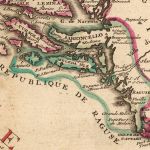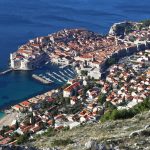If you’ve ever been to Dubrovnik, then you’ll have walked down it, but how much do you really know about it?
For those who have visited the Pearl of the Adriatic, you’ll no doubt have walked along Stradun, taken a million photos of it, admired the shiny, almosr glass-like stone reflecting the often harsh rays of the sun and imagined the countless feet that have walked on the very same ground over the centuries that have passed.
Stradun is one of the top symbols of Croatia’s southernmost destination, one of the most recognisable attractions in Dubrovnik and the playground of every photographer (if he can manage to get up early enough to ensure less crowds!).
Protected by UNESCO, the street that separates the two sides of the famous Old City has long since been referred to as the most beautiful street in Croatia and has been listed as one of the most beautiful streets in the world, I don’t think anyone in their right mind would argue with either of those claims, but just how much do you really know about the unmistakable icon of Croatia’s tourist Mecca?
300 meters of pure history:
Just a street, albeit a pretty one, you might think. You couldn’t be more wrong. Also known as the Placa (derived originally from the Greek word ”Platea”, or Stradone in Italian, Stradun (originally Venetian, with a rough meaning of ”big street”) connects the eastern and the western entrance to the Old City in the shortest, most direct way possible and has many, many stories to tell. Born out of increasingly closer ties between the Croats, the Slavs, the Greeks and the Romans, Stradun in its original form was a product of both economic and social ties back in the twelfth century, becoming predominantly Croatian in the fourteenth century. Here’s just a few facts about one of Croatia’s most iconic streets.
Stradun is made from limestone, not from marble:
If I had a euro for every time I heard someone say ”wow look at that shiny marble”, well, I wouldn’t be writing for a living, put it that way. The sheer sparkling clean feel that Straduns ancient stone gives off could easily fool someone into believing it was marble or some other material with similar properties to it, but alas, it is merely limestone, paved back in 1468, cleaned by feet and the soles of an incomprehensible amount of shoes over the generations.
Stradun used to be a channel of water:
That’s right, although it is extremely difficult to imagine in this day and age, the dry, often unforgivingly slippery stone of Stradun used to actually be a body of water that once separated the formerly autonomous Republic of Ragusa from a former forest settlement known as Dubrava back in the eleventh century, until the territory was eventually reclaimed by Ragusa and the two areas joined together at the end of the twelfth, and the beginning of the thirteenth century, becoming one, considerably larger settlement.
Both ends, Pile Gate (Vrata od Pila) and Ploče Gate (Vrata od Ploča) are marked by fifteenth century fountains:
The western entrance to Stradun and indeed to the UNESCO Old City, Pile, is marked by ”big” Onofrio’s Fountain, which is still a common meeting place even today, and the eastern entrance at Ploče, is marked by ”small” Onofrio’s Fountain. The two fountains are characterised by their beautiful, intricate architectural facades and work well to hydrate the masses to this very day, as the clean water they produce is safe and drinkable. Why keep paying for water when the water produced by these ancient wonders mark a lesser known part of Dubrovnik’s history – the fact that it had clean, drinkable running water and a proper sewage system as London bathed in its own filth.
The 1667 earthquake saw Stradun take on its current appearance:
Back in 1667 (of course, you must remember), an earthquake of massive proportions rocked Dubrovnik (then the autonomous Republic of Ragusa/Dubrovnik Republic/Dubrovačka Republika) and saw it all but destroyed, the lives of thousands of citizens, then the vast majority of the city’s residents, were also taken by the dramatic event. Stradun adopted its ”modern” look following that tragic event, as the former appearance of the main thoroughfare, which it had been since the thirteenth century following the filling in of the channel that once existed there, was not as poker straight as it is today. Naturally, following the destruction of property caused by the enormous earthquake, fires broke out across the city, forcing the city government to have a rethink about buildings and their layouts. The reconstruction and rebuilding of the city following the horrendous natural disaster saw a much more uniform approach to house building, which is why the mainly Baroque-style city is built in such an undeviating way today, with buildings constructed during the seventeeth century all having the same design as a safety measure against fire.
Stradun is the ”main stage” for almost all processions that currently take place in Dubrovnik:
From the festivity of Saint Blaise (Sveti Vlaho), a celebration of the city’s beloved patron saint and eternal guardian whose likeness can be seen almost everywhere, to the Trombunjeri to religious processions and New Year’s Eve celebrations, Stradun is the stage for them all. The street represents much more than words could to the city, and all the main events, both traditional and non-traditional naturally take place there, including concerts and performances of all kinds, particularly during the Dubrovnik Summer Festival, and much more recently, the Dubrovnik Winter Festival, and even the first sporting event to kick off the new year in Croatia, DuRun10k.
Stradun was heavily damaged during the Homeland War:
When the JNA (Yugoslav People’s Army) accompanied by their Serbian-Montenegrin counterparts brutally attacked Dubrovnik during the unjustifiable and primitive Siege of Dubrovnik, Stradun took several heavy hits from continuous shelling. Fires raged through the buildings situated along Stradun and very many damages from shells can still be seen today, both on the buildings along Stradun and on the very limestone paved street itself.
Stradun was the stage of a tennis match between John McEnroe and Goran Ivanisevic:
If Stradun can do anything, then it can be extremely adaptable. The 300 meter long street was the stage, or should I say court, of a tennis match televised live in ten countries between Croatia’s Goran Ivanisevic and America’s John McEnroe. The match, which took place in the summer of 2010, was viewed not only in several countries, but by a live audience of 600.
Walked along by the feet of an incomprehensible number of people since the closing of the twelfth century, Stradun is much more than a quick A to B walkway, marked by stunning architecture and no longer flooded by water but by history and culture, it is worth paying attention to the ground you’re walking along when taking a stroll down Stradun and admiring the history surrounding you. The very floor under your feet has its own stories to tell.









